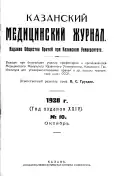Реакция оседания эритроцитов (РОЭ) при острых инфекциях
- Авторы: Вольтер Б.А.1, Александров К.Г.1
-
Учреждения:
- Клиника инфекционных болезней Казанского гос. университета
- Выпуск: Том 24, № 10 (1928)
- Страницы: 983-993
- Тип: Статьи
- URL: https://bakhtiniada.ru/kazanmedj/article/view/91132
- DOI: https://doi.org/10.17816/kazmj91132
- ID: 91132
Цитировать
Полный текст
Аннотация
Описанная R. Fahrаеus’ом и хорошо разработанная за последнее время РОЭ не перестает привлекать внимание клиницистов, как одна из тонких биологических реакций. Не вдаваясь в изложение не раз уже описанной истории этой реакции, заметим, что биологические основы ее нам вo многом еще неясны. Несмотря на работы целого ряда исследователей, среди которых есть имена с мировой известностью, как Abderhalden, Michaelis, Rona, Bürker и др.), мы до сих пор еще не имеем общепризнанной теории, объясняющей все стороны разбираемого феномена. Наибольшим признанием пользуется коллоидно - химическая теория, по которой ускорение РОЭ зависит от увеличения в плазме крови положительно заряженных глобулинов, а замедление—от увеличения альбуминов, заряженных отрицательно.
Ключевые слова
Полный текст
Открыть статью на сайте журналаОб авторах
Б. А. Вольтер
Клиника инфекционных болезней Казанского гос. университета
Автор, ответственный за переписку.
Email: info@eco-vector.com
Россия
К. Г. Александров
Клиника инфекционных болезней Казанского гос. университета
Email: info@eco-vector.com
Россия
Список литературы
- А. С. Соловцова. Клиническая медиц., 1926, № 4.
- С. Я. Штернберг и Н. И. Кириченко. Врач. дело, 1925, № 1.
- В. Д. Вышегородцева и И. И. Гуревич. Труды VIII съезда терапевтов.
- М. Р. Борок и В. И. Мордвинкина. Врач. дело, 1926, № 3.
- Büchler. Zeit. f. Kinderheilk., Bd. 34.
- Gereke. Klin. Woch., № 44, 1927.
- Басов и Гинсберг. Клинич. мед., 1927, № 20.
- В. В. Кедровский. Врач. дело, 1925, № 22.
- Кашаева и Клюева. Казан. мед. ж., 1926, № 11.
- Linzenmeier. Münch. med. Woch., 1923, № 40.
- Равинский и Баккал. Педиатрия, т. X, 1927, № 2.
- А. Э. Мандельштам. Реакция оседания эритроцитов в гинекологии. Ленинград. 1925.
- Rodozavljevié и Ristil. Zet. d. ges. u. exp. M., 1926, S. 48.
- M. T. Фридман. Врач. дело, 1925, № 1.
- Писаревский. Рус. клин., 1927, стр. 193.
- Пейсахович. Врач. дело, 1925, № 18.
- Б. И. Словцов. Уросемиология. СПБ. 1912.
- В. С. Вайль. Педиатрия, т. X, № 2, 1927.
Дополнительные файлы





